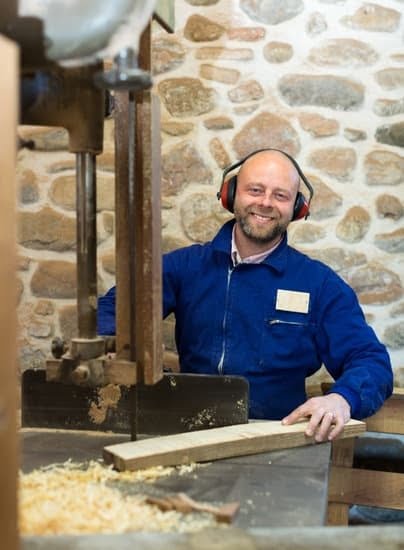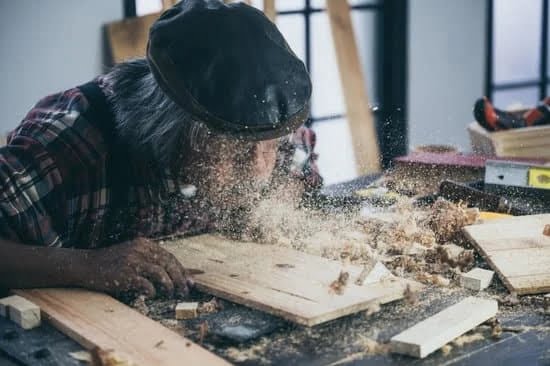Woodwork is a captivating craft that has been practiced for centuries, with its timeless allure continuing to attract enthusiasts today. While the art of woodworking encompasses a wide range of skills and techniques, one aspect that stands out as particularly crucial is marking out.
Marking out plays a vital role in achieving precision and accuracy in woodwork projects, ensuring the perfect fit of joints, precise measurements, and flawless execution. In this article, we will explore what marking out in woodwork entails, the essential tools and techniques involved, and why it is essential for achieving woodworking mastery.
The popularity of woodwork can be attributed to its unique blend of creativity and craftsmanship. It allows individuals to transform raw timber into functional and aesthetically pleasing objects, whether it be furniture, decor pieces, or even intricate carvings. With its ability to connect us to nature and evoke a sense of nostalgia in an increasingly digital world, woodworking has become more than just a hobby; it is an expression of artistry and passion.
However, achieving excellence in woodwork goes beyond simply having the right tools or materials at hand. Precision is key when working with wood, as even the slightest deviation can compromise the entire project. This is where marking out comes into play – it serves as the foundation for accuracy in woodworking. By carefully measuring and transferring dimensions onto the workpiece through markings, woodworkers can ensure that every cut and joinery decision aligns perfectly with their vision.
What Is Marking Out in Woodwork
Marking out is a fundamental aspect of woodwork that involves the process of applying precise measurements and markings on a piece of wood to guide the cutting, shaping, and assembly of various woodworking projects. It serves as the foundation for achieving accuracy and precision in woodworking, ensuring that each component fits perfectly and the final product meets the desired specifications.
In basic terms, marking out involves using various tools such as marking gauges, layout pencils, marking knives, and try squares to create lines or notations on the wood surface. These markings serve as visual indicators for where cuts should be made or joints should be created. By accurately following these markings during the construction process, woodworkers can ensure that all pieces fit together seamlessly and result in a high-quality finished product.
Proper marking out is crucial for several reasons. Firstly, it helps ensure that all parts of a woodworking project are aligned correctly, allowing for precise joinery and clean assembly. Without accurate markings, there is a risk of misaligned cuts or joints not fitting properly, leading to gaps or instability in the final structure.
Secondly, marking out aids in achieving consistent dimensions throughout a project, resulting in a professional-looking finish. By following precise measurements during marking out, woodworkers can avoid uneven sizes or proportions that may compromise the aesthetics or functionality of their work.
Understanding Marking Out Techniques and Tools
To achieve accurate marking out in woodwork projects, it is essential to understand the different techniques and tools involved. The choice of technique often depends on factors such as personal preference, complexity of the project, or specific requirements dictated by design plans.
One common technique used in marking out is measuring and transferring dimensions using measuring tapes, dividers, and squares. Measuring tapes are used to determine lengths while dividers help mark equal distances precisely. Squares play a crucial role in creating perpendicular lines necessary for accurate joinery.
When it comes to tools specifically designed for marking out, there are several options available. Marking gauges are frequently used to scribe lines parallel to an edge or replicate measurements accurately. Layout pencils, on the other hand, are useful for making visible marks that can be easily erased or modified as needed. Marking knives provide a fine, precise cut along the edge of a ruler or template and are particularly effective for creating crisp lines.
Investing in top-quality marking out tools is essential to ensure accuracy and longevity. When selecting these tools, it is crucial to consider factors such as durability, ease of use, and precision. Woodworkers should also keep in mind their specific project requirements when choosing between different types of tools available in the market. By using reliable and well-maintained tools, woodworkers can achieve greater accuracy and minimize the risk of errors during the marking out process.
| Common Marking Out Tools | Functions | Characteristics |
|---|---|---|
| Marking Gauges | To scribe lines parallel to an edge or replicate measurements accurately | Durable, adjustable, capable of making precise markings |
| Layout Pencils | To make visible marks that can be easily erased or modified | Easily erasable, capable of creating visible yet accurate marks |
| Marking Knives | To provide a fine, precise cut along the edge of a ruler or template | Razor-sharp blade, allows for crisp and clean lines on wood surface |
| Try Squares | To create perpendicular lines necessary for accurate joinery | Right-angled, reliable measurements, solid construction |
The Essential Tools for Marking Out in Woodwork
When it comes to marking out in woodwork, having the right tools is essential. These tools not only help achieve precision and accuracy but also contribute to the overall quality of a woodworking project. Below are some of the fundamental tools used in marking out and their specific functions:
- Marking Gauges: A marking gauge is a versatile tool used to scribe lines parallel to an edge or surface. It typically consists of a beam, a fence, and a cutting or marking element such as a pin or knife. The fence is adjustable, allowing woodworkers to set the desired distance from the edge accurately. This tool is commonly used for tasks like marking mortise and tenon joints or laying out various lines on the wood surface.
- Layout Pencils: Layout pencils are another essential tool for marking out in woodwork. They come in different grades, with softer grades leaving darker marks that are easier to see and follow while making cuts. These pencils are ideal for drawing guidelines, notations, or notes on the wood’s surface during layout and planning stages.
- Marking Knives: Marking knives are precise cutting tools used for scoring fine lines on wood surfaces. Unlike regular knives, these have extremely sharp and thin blades that create clean cuts without tearing or splintering the wood fibers. The lines made by marking knives serve as accurate references when making cuts or joinery work.
- Try Squares: Try squares are right-angled measuring tools used for checking and marking squareness in woodworking projects accurately. They consist of a blade and handle at a 90-degree angle, ensuring that perpendicular lines can be drawn with confidence.
Selecting top-quality marking out tools is crucial for achieving accurate results in woodworking projects. Here are some tips to keep in mind when choosing these tools:
- Consider the material quality: Opt for well-made tools with sturdy construction and durable materials to ensure they will last for a long time.
- Test the functionality: Before purchasing, try out the tools to ensure that they perform as expected. Check for sharpness, sturdiness, and ease of adjustment if applicable.
- Read reviews and consult professionals: Take advantage of online resources, user reviews, or seek advice from experienced woodworkers to gain insights into which brands or models are reliable and recommended in the industry.
Using the right marking out tools is an important step towards achieving accuracy and precision in woodworking projects. These tools not only contribute to the overall quality of the finished piece but also make the process more enjoyable and efficient. By investing in top-quality marking out tools and mastering their use, woodworkers can elevate their craftsmanship to new heights.
Mastering the Art of Measuring and Transferring Dimensions
In the realm of woodworking, mastering the art of measuring and transferring dimensions is an essential skill that every woodworker must possess. This crucial step in the marking out process lays the foundation for accurate and precise woodworking projects. By understanding and employing proper techniques, woodworkers can ensure their creations meet their desired specifications.
Accurately measuring and transferring dimensions requires the use of specific tools that are designed to facilitate precision. One of the most commonly used tools for this purpose is the measuring tape. When using a measuring tape, it is important to ensure it is pulled taut without any slack, as this can result in inaccuracies. Additionally, woodworkers should pay attention to the measuring increments on the tape and select one that aligns with the desired measurements for their project.
Dividers are another valuable tool when it comes to accurately transferring dimensions in woodworking. These tools consist of two sharp points connected by a hinge, allowing woodworkers to create equally spaced markings or transfer measurements from one piece of wood to another. By adjusting the distance between the points based on measurements taken with a ruler or any other measuring tool, woodworkers can accurately reproduce dimensions on different surfaces.
Squares, such as try squares or combination squares, are also essential for transferring dimensions accurately in woodworking. These tools provide perpendicular reference lines that help establish right angles and ensure precise cuts and joints. It is important to choose squares made from high-quality materials that maintain their squareness over time.
While mastering measurement and dimension transfer may seem straightforward, challenges can arise along the way. One common challenge faced by woodworkers is ensuring accuracy when measuring curved or irregular surfaces. In these cases, it may be helpful to take multiple measurements at different points along the curve or irregularity in order to get a more accurate representation of its shape.
By honing their skills in measuring and transferring dimensions, woodworkers gain confidence in producing exceptional pieces with meticulous craftsmanship. With practice and attention to detail during this crucial step, woodworkers can achieve the precision necessary for successful woodworking projects.
Types of Markings and Their Uses in Woodwork Projects
In woodwork projects, marking out is an essential step that involves creating precise and accurate markings on the wood surface. These markings serve a variety of purposes, guiding cuts, identifying joints, or marking screw holes. Understanding the different types of markings used in woodwork is crucial for achieving successful woodworking projects.
One common type of marking is guidelines. Guidelines are straight lines that are drawn on the wood surface to provide a reference point for making accurate cuts or shaping the wood. These lines help ensure that measurements and cuts are consistent throughout the project.
Notations are another type of marking used in woodwork. Notations involve writing important information directly on the wood surface, such as dimensions, angles, or specific instructions. This helps woodworkers keep track of measurements and ensure accuracy during the construction process.
Another important type of marking is notches. Notches are small indentations made on the wood surface to indicate where joints or connections should be made. These notches provide a clear guide for assembling wood pieces together and ensuring proper alignment.
By utilizing these various types of markings effectively, woodworkers can achieve precise and accurate results in their projects. Whether it’s creating intricate details in furniture or constructing simple joints in carpentry work, markings play a crucial role in achieving woodworking mastery.
| Type of Marking | Use |
|---|---|
| Guidelines | To guide cuts or shape the wood accurately |
| Notations | To write important information such as dimensions and angles |
| Notches | To indicate where joints or connections should be made |
Importance of Precision
Precision is paramount in the world of woodwork, and marking out plays a crucial role in achieving that precision and ensuring the overall quality of a project. Even minor errors during the marking out process can lead to significant discrepancies in dimensions and aesthetics, highlighting the importance of meticulous attention to detail. In this section, we will explore how marking out impacts woodwork quality and provide tips and strategies for achieving precision.
One of the key ways that marking out affects woodwork quality is by ensuring accurate measurements and transfers of dimensions. Accurate measurement is essential for creating well-fitting joints, determining proper proportions, and achieving overall balance in a woodworking project. By using measuring tapes, dividers, and squares correctly, woodworkers can ensure that their projects are built to the precise specifications required.
Another important aspect influenced by marking out is the overall aesthetic appeal of a woodwork project. Properly marked guidelines ensure that cuts are made accurately and align properly, resulting in clean lines and symmetrical designs. Markings also help identify areas where notches or screws need to be placed, ensuring that these elements are integrated seamlessly into the final piece.
To achieve precision in marking out, it is important for woodworkers to consider several factors. Firstly, adequate lighting is crucial as it allows for clear visibility of markings and ensures that they are executed accurately. Additionally, refining one’s marking out technique through practice and attention to detail is vital for achieving consistent results.
Patience is also key when it comes to marking out as rushing through this step could result in errors that have a cascading effect on the entire project. Taking the time to double-check measurements before making any cuts or marks can save valuable time and resources down the line.
Best Practices
Selecting the Right Timber
Before diving into the marking out process, it is essential to start with selecting the right timber for your woodworking project. The choice of timber will impact the overall quality and durability of your final piece. When selecting timber, consider factors such as its species, grain pattern, moisture content, and stability.
Start by identifying the type of wood that will best suit your project. Different woods have varying characteristics in terms of hardness, color, and workability. Consider the nature of your project and choose a wood species that aligns with your desired outcome.
Additionally, pay attention to the grain pattern of the timber. Grain patterns can enhance or detract from the visual appeal of a woodwork piece. Decide whether you want a straight grain or more pronounced grains for aesthetic purposes.
Lastly, take note of the moisture content and stability of the wood before starting any measurements or markings. Ensure that the timber is properly dried and seasoned to avoid any warping or shrinking issues down the line.
Executing Accurate Markings
Once you have selected the appropriate timber, now comes the crucial step of executing accurate markings on your material. The accuracy of these markings will directly impact how well your project comes together in the end.
To begin, make sure your work area is well-lit so that you can clearly see what you are doing. Shadows and poor lighting can lead to inaccuracies in measurements and markings. Position yourself so that you can view your workpiece from different angles to ensure precision and accuracy.
Next, gather all the necessary marking out tools mentioned earlier in this article – marking gauges, layout pencils, marking knives, try squares – and make sure they are in good condition for use. Dull blades or worn-out tools can result in inaccurate markings.
When using each tool for marking out specific dimensions or lines, take your time and exert consistent pressure to ensure clear and distinct marks. Remember to measure twice and mark once to avoid any potential errors that may arise from hasty or careless measurements.
Enhancing Efficiency and Accuracy
To enhance your efficiency and accuracy in marking out, there are several additional strategies you can incorporate into your workflow. One effective technique is utilizing story sticks or templates for repetitive markings. Creating a template of standardized dimensions allows you to quickly transfer markings without having to remeasure each time.
Another helpful tip is to use contrasting color pencils or markers when making multiple markings on your workpiece. This makes it easier to differentiate between lines and ensure that you are accurately following your plans or design.
Furthermore, consider using a magnifying glass or ruler with a built-in magnifier when working on small-scale projects that require intricate markings. These tools can help improve accuracy by providing a clearer view of the area you are marking.
Lastly, practice patience and refine your marking out technique over time. Woodworking is an art form that requires attention to detail and precision, which can only be developed through consistent practice and refinement of your skills.
By following these best practices, you will be well on your way to mastering the art of marking out in woodwork and achieving more precise and accurate woodworking projects. Remember, the key lies in selecting the right timber, executing accurate markings, and continually improving your efficiency and technique throughout the process.
Troubleshooting Common Marking Out Challenges and Solutions
Identifying Common Marking Out Challenges
When it comes to marking out in woodwork, there are several challenges that woodworkers may encounter. These challenges can often hinder the accuracy and precision of the markings, leading to discrepancies in dimensions and aesthetics. It is crucial for woodworkers to be aware of these common challenges so they can effectively troubleshoot and overcome them.
One common challenge is dealing with curved or irregular surfaces. When marking out on a surface that is not flat, such as a rounded edge or irregularly shaped piece of wood, traditional marking tools may not produce accurate results. Another challenge is ensuring the visibility of markings on darker woods or highly figured grains. The contrast between the marking tool and the wood can make it difficult to see the lines clearly.
Additionally, achieving consistent depths when making notches or mortises can be challenging, especially if done by hand. It requires skill and practice to ensure uniformity throughout the project. Another challenge arises when transferring measurements from one part of a project to another. The accuracy of these transfers directly affects the overall quality of the finished piece.
Practical Solutions and Troubleshooting Methods
To overcome these common marking out challenges, there are several practical solutions and troubleshooting methods that woodworkers can employ.
For dealing with curved or irregular surfaces, specialized tools such as contour gauges or flexible rulers can be used to accurately trace the contour onto a template or directly onto the workpiece. This method ensures that precise curvature is maintained during the marking process.
When working with darker woods or highly figured grains, using a contrasting color for markings can greatly enhance visibility. White chalk or graphite pencils are popular choices that provide good contrast against dark surfaces.
To achieve consistent depths when making notches or mortises, utilizing depth stop accessories on drills, routers, or chisels can help maintain uniformity throughout the project. These adjustable stops allow woodworkers to set a specific depth and ensure that each cut matches the desired measurements.
When transferring measurements, always double-check by measuring again to reduce the risk of errors. It can also be helpful to use layout tools such as story sticks or marking templates to ensure accurate transfers across multiple parts of a project.
Dealing with Curved or Irregular Surfaces
Curved or irregular surfaces pose unique challenges when it comes to marking out in woodwork. These surfaces require special attention to achieve accurate markings. One solution is to create a template or jig that conforms to the curved surface. This template can then be used as a guide for transferring the correct measurements onto the workpiece.
Another approach is to utilize flexible rulers or contour gauges that can bend and conform to the shape of the surface. By carefully tracing along these tools, woodworkers can accurately mark out curves or irregular shapes.
For complex curved surfaces, advanced techniques such as French curves or flexible curves can be utilized. These specialized tools are designed specifically for creating precise and smooth curves in woodworking projects.
By understanding these challenges and implementing practical solutions, woodworkers can effectively troubleshoot common marking out issues and ensure the accuracy and precision of their woodworking projects. Overcoming these challenges leads to improved craftsmanship and greater satisfaction in producing flawless pieces of woodwork.
Conclusion
In conclusion, marking out is an essential aspect of woodwork that cannot be overlooked. This article has explored the basics of marking out, including its definition, techniques, and tools. We have discussed the importance of precision in marking out and how it directly impacts the overall quality of a woodworking project.
Accurate marking out is crucial for achieving precision and accuracy in woodworking. Even minor errors in measurements or markings can lead to significant discrepancies in dimensions and aesthetics. Therefore, it is vital for woodworkers to invest time and effort into mastering marking out techniques.
By following the best practices outlined in this article, woodworkers can enhance their efficiency and accuracy during the marking out process. From selecting the right timber to executing the markings, every step is important for achieving flawless results. It is recommended to refer to visual aids or diagrams to aid comprehension of the process.
Ultimately, proper marking out allows woodworkers to accomplish mastery in their craft. It is through precise markings that woodworking projects can be brought to life with impeccable craftsmanship. The satisfaction and pride that come from producing flawless woodworking projects are unparalleled. So, let us embrace the power of marking out and strive for excellence in our woodwork endeavors.
Frequently Asked Questions
What does marking out mean in woodwork?
In woodwork, marking out refers to the process of measuring and laying out the dimensions or features on a piece of wood or wooden material. This is typically done using various tools such as rulers, squares, compasses, or marking knives.
By making precise marks on the wood surface, a woodworker can accurately plan and prepare for cutting, shaping, or joining the material.
What is the purpose of marking out?
The purpose of marking out in woodwork is to ensure accuracy and precision in the final product. By marking out specific measurements and features on the wood before any cutting or shaping begins, a woodworker can minimize errors and reduce wastage of materials.
Marking out also helps in visualizing the design and layout of a project, allowing for adjustments or modifications before any irreversible actions are taken. Overall, it serves as a crucial step in the woodworking process to achieve desired outcomes.
What is defined marking out?
Defined marking out involves precisely measuring and transferring specific dimensions from a blueprint or design onto the actual piece of wood. It requires careful attention to detail and accurate readings to ensure that every mark corresponds with the intended measurements.
In defined marking out, there is little room for error as it directly affects how well components fit together during assembly or how accurately cuts are made while shaping the wood. This technique involves using tools like squares and measuring devices to create clear lines and references that guide subsequent steps in the woodworking process.

Hi everyone! I’m a woodworker and blogger, and this is my woodworking blog. In my blog, I share tips and tricks for woodworkers of all skill levels, as well as project ideas that you can try yourself.





